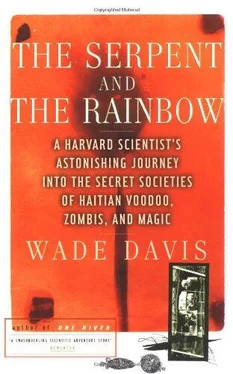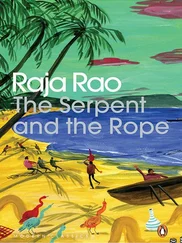Wade Davis - The Serpent and the Rainbow
Здесь есть возможность читать онлайн «Wade Davis - The Serpent and the Rainbow» весь текст электронной книги совершенно бесплатно (целиком полную версию без сокращений). В некоторых случаях можно слушать аудио, скачать через торрент в формате fb2 и присутствует краткое содержание. Год выпуска: 1985, Издательство: Simon & Schuster, Жанр: Старинная литература, на английском языке. Описание произведения, (предисловие) а так же отзывы посетителей доступны на портале библиотеки ЛибКат.
- Название:The Serpent and the Rainbow
- Автор:
- Издательство:Simon & Schuster
- Жанр:
- Год:1985
- ISBN:нет данных
- Рейтинг книги:5 / 5. Голосов: 1
-
Избранное:Добавить в избранное
- Отзывы:
-
Ваша оценка:
- 100
- 1
- 2
- 3
- 4
- 5
The Serpent and the Rainbow: краткое содержание, описание и аннотация
Предлагаем к чтению аннотацию, описание, краткое содержание или предисловие (зависит от того, что написал сам автор книги «The Serpent and the Rainbow»). Если вы не нашли необходимую информацию о книге — напишите в комментариях, мы постараемся отыскать её.
The Serpent and the Rainbow — читать онлайн бесплатно полную книгу (весь текст) целиком
Ниже представлен текст книги, разбитый по страницам. Система сохранения места последней прочитанной страницы, позволяет с удобством читать онлайн бесплатно книгу «The Serpent and the Rainbow», без необходимости каждый раз заново искать на чём Вы остановились. Поставьте закладку, и сможете в любой момент перейти на страницу, на которой закончили чтение.
Интервал:
Закладка:
Tetrodotoxin is a most peculiar molecule. No one is exactly sure where it originated. Generally, such specialized compounds pop up just once over the course of evolution, and as a result are only found in closely related organisms, derived presumably from a common ancestor. For the longest time, tetrodotoxin appeared to be isolated to a single family of fish. Then, to the surprise of biologists, it turned up in an amphibian, the California newt, a totally unrelated creature. Subsequent research found it in the goby fish from Taiwan, atelopid frogs from Costa Rica, and the blue-ringed octopus from the Great Barrier Reef of Australia. Such an erratic distribution suggested to some scientists that the toxin originated lower in the food chain, perhaps in a small marine organism.
Within the puffer fish themselves, toxicity is correlated with the reproductive cycle and is higher in females, but the remarkable variability in toxin levels among separate populations of the same species has prompted similar suggestions that the concentration of the toxin may be linked to food habits. Puffer fish grown in culture, for example, do not develop tetrodotoxins, and it is possible that the puffer fish, in addition to synthesizing tetrodotoxins, may serve as transvectors of either tetrodotoxin or ciguatoxin, a different chemical that originates in a dinoflagellate and causes paralytic shellfish poisonings. The symptoms of ciguatera poisoning are similar to those of tetrodotoxin and include tingling sensations, malaise, nausea, and digestive distress, with death resulting from respiratory paralysis.
In Australia, still today as throughout their history, the aborigines have a very strange plant, actually a tree, that they call ngmoo . They carve holes in its trunk and fill them with water, and within a day have an interesting beverage that produces a mild stupor. The branches and leaves, they have also learned, when placed in standing water quite effectively intoxicate eels, forcing them to surface where they can be killed. Knowledge of the remarkable properties of this plant found its way north to New Caledonia. There the native inhabitants discovered that the leaves could be used to make an effective antidote to ciguatera poisoning, an observation that modern science has confirmed. The plant is Duboisia myoporoides , and like many members of the potato family it has a number of potent chemicals including nicotine, atropine, and scopolamine. There is no known medical antidote for tetrodotoxin, but in the laboratory it has been shown that, as in the case of ciguatera poisonings, atropine relieves certain symptoms.
Datura stramonium , like its relative from New Caledonia, contains atropine and scopolamine, and hence could be serving as an effective but unrecognized counteragent to the zombi poison.
The investigation had come full circle. Ironically, the plant I had originally suspected to be the source of the drug that allowed an individual to be buried alive turned out to be, if anything, a possible antidote, which, at the same time, was instrumental in actually creating and maintaining the zombi state. For if tetrodotoxin provided the physiological template upon which cultural beliefs and fears could go to work, datura promised to amplify those mental processes a thousand times. Alone, its intoxication has been characterized as an induced state of psychotic delirium, marked by disorientation, pronounced confusion, and complete amnesia. Administered to an individual who has already suffered the effects of the tetrodotoxin, who has already passed through the ground, the devastating psychological results are difficult to imagine. For it is in the course of that intoxication that the zombi is baptized with a new name, and led away to be socialized into a new existence.
Further evidence of the makeup of the zombi poison came two days later south of the capital near the town of Leogane. Several weeks previously we had established contact with a houngan named Domingue. His son, named Napoléon, was a well-known malfacteur, and he had a message for me at Beauvoir’s. My meeting with Napoléon was brief, but it yielded two poisons of note. The most toxic, by Napoléon’s account, was made from human remains alone. It consisted of a ground leg bone, forearm and skull, mixed with dried and pulverized bits of dried cadaver, and it was the first and only poison I encountered administered in the reputedly most traditional way. Having rubbed one’s hands with the protective lotion—again a mixture of lemons, ammonia, and clairin—the killer sprinkled the powder in the form of a cross on the ground, while naming the intended victim. The recipient need only walk over that cross to be seized with violent convulsions. If the powder was placed in the victim’s food, the action would be immediate and permanent.
The second preparation was a more familiar mixture of insects, reptiles, centipedes, and tarantulas. In place of the bouga toad, two locally recognized varieties of the tree frog were added. Napoléon also included the sea toad, the crapaud de mer. The onset of the poison was characterized by the feeling of ants crawling beneath the skin, precisely the way that Narcisse had described his first sensations. Besides evidence of yet another preparation based on the puffer fish, Napoléon gave further indication of the importance of correct dosage. He mentioned that the animal powder was most effective if ingested by the victim, and he cautioned that his two preparations should never be mixed. Together they would act too explosively; the victim would be too dead and would never rise again.
I left Leogane confirmed in my conclusion that tetrodotoxin was the pharmacological basis of the zombi poison, a conviction that was reinforced by subsequent collections at various localities along the coast of Haiti. Finally I felt I could let the issue of the poison rest. It was time to move on to other matters that had claimed my interest since returning to Haiti.
Herard Simon called early the next day and insisted on seeing Rachel and me immediately. We left that afternoon, picked him up in Gonaives, and drove directly to Petite Rivière de l’Artibonite. Arriving at the army caserne by dusk, we followed Herard past the sentry and into the private quarters of the commander. After sending the commander on an errand, Herard asked his orderly to bring us food and a bottle of rum. Then we waited. Past a broken shutter, the rain poured down, and inside a long row of cells I could just make out the prisoners clinging to the bars, trying to keep their feet out of the water.
Herard is not a man who likes questions. I tried three. I asked first about the astral zombi that had been brought by the mountain peasants.
“In that bottle was the soul of a human being,” Herard replied, “the control of which is an ominous power. It is a ghost, or like a dream; it wanders at the command of the one who possesses it. It was a zombi astral captured from the victim by the magic of the bokor.”
“What about the poison you gave me?”
“A poison kills. You put it in food. I gave you no poison.”
“But the powder?”
“Yes. Powder is powder, poison is poison. The powder is the support of the magic. Only the truly great work magic alone. Small people pretend, but watch and you’ll see the hand of powder. There are some, and I know them, who can stand in front of an army and throw a spell on anyone.”
“To steal the soul?”
“What else? If you want the flesh to work, you can’t fool with a little powder dust on the ground. You take a bamboo tube and blow it all over him and you rub it into the skin. Only then shall the zombi cadavre rise.”
With the realization that there were two kinds of zombis and two means of creating them, many of my loose ends came together. Clearly what LaBonté and Obin had offered was a powder that, embued with sorcery and triggered by a magical act on my part, would kill my enemy. That was what Mme. Jacques had been telling me—“the magic makes you the master.” It was, in effect, voodoo death, the Haitian equivalent of the aboriginal practice of pointing the bone. It would not have been particularly effective within the mindset of my society, but that wasn’t their problem, it was mine.
Читать дальшеИнтервал:
Закладка:
Похожие книги на «The Serpent and the Rainbow»
Представляем Вашему вниманию похожие книги на «The Serpent and the Rainbow» списком для выбора. Мы отобрали схожую по названию и смыслу литературу в надежде предоставить читателям больше вариантов отыскать новые, интересные, ещё непрочитанные произведения.
Обсуждение, отзывы о книге «The Serpent and the Rainbow» и просто собственные мнения читателей. Оставьте ваши комментарии, напишите, что Вы думаете о произведении, его смысле или главных героях. Укажите что конкретно понравилось, а что нет, и почему Вы так считаете.












